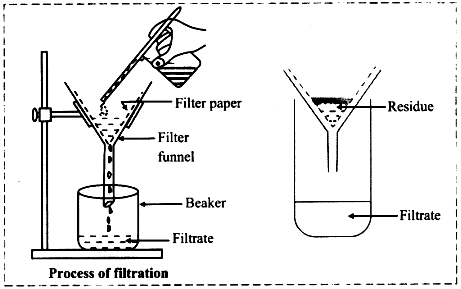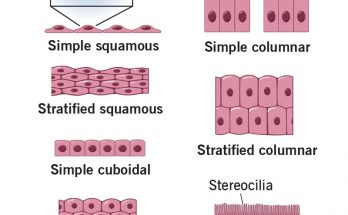Filtration Definition
The process of removing insoluble solids from a liquid by using a filter is known as Filtration. Filtration is used for separating insoluble substances from a liquid. For example, separation of tea leaves from prepared tea is a good example of Filtration.
Process of Filtration

The mixture of insoluble solid and the liquid is poured into a filter paper cone fixed in a funnel by using a glass rod as a guide.
The liquid passes through the filter paper and collects in the beaker kept below the funnel.
The solid particles (being bigger in size) do not pass through the filter paper and remain behind on the filter paper.
The solid substance left behind on the filter paper is called residue. The clear liquid obtained is called Filtrate.
By filtration a mixture of insoluble solid in a liquid is separated into the ‘solid’ and ‘clear liquid’.
Examples of Filtration
Filtration of Chalk Water Mixture
A mixture of chalk and water is separated by filtration. When the mixture of chalk and water is
poured on the filter paper fixed in a funnel, then clear water passes through the filter paper and collects as filtrate. The chalk particles remain behind on filter paper as residue.
Filtration of Sand Water Mixture
A mixture of sand and water can also be separated by filtration. When the mixture of sand and water is poured on a filter paper fixed in a funnel, then clear water passes through filter paper and collects as filtrate. The sand remains behind on the filter paper in the form of a residue.
Filtration in Everyday Life
In science experiments we use a filter paper as ‘filter’ for carrying out the process of filtration.
But in everyday life, different kinds of ‘filters’ are used.
For example, a wire-mesh, a piece of cotton, a piece of muslin cloth (fine cloth), strainer, or even a layer of sand, can be used as ‘filters’ for various purposes. The size of holes of the filter to be used depends on the size of the solid particles to be separated from the liquid.
Filtration of Tea
When we make tea, we add tea-leaves. To separate used tea-leaves we pour the prepared tea over a tea-strainer. The tea-strainer has a wire mesh in it which acts as a filter. The liquid tea passes through the small holes of a tea-strainer and collects in the cup below. The tea-leaves
(being bigger in size) do not pass through the tea-strainer.
The tea-leaves remain behind on the tea-strainer. In this way, the used tea-leaves are separated from prepared tea by the method of filtration.
Filtration of Juice
Fresh fruit juice is also filtered by using a strainer as filter to remove the seeds and solid particles of pulp.
Filtration of Drinking Water
At water treatment Plants (which supply drinking water to the whole city), the river water or lake
water is filtered by using ‘Sand Filters’.
Filtration of Sewage Water
In cities, Sewage Water (dirty drain water) is filtered through big metallic filters to separate solid materials present in it so as to avoid choking of underground drains (called sewers).
Limitations of Filtration Process
The mixture of two liquids cannot be separated by filtration.
For example, a mixture of milk and water cannot be separated by filtration. Also, filtration cannot remove any solid substances which are dissolved in a liquid. For example, sugar dissolved in tea cannot be separated by filtration

